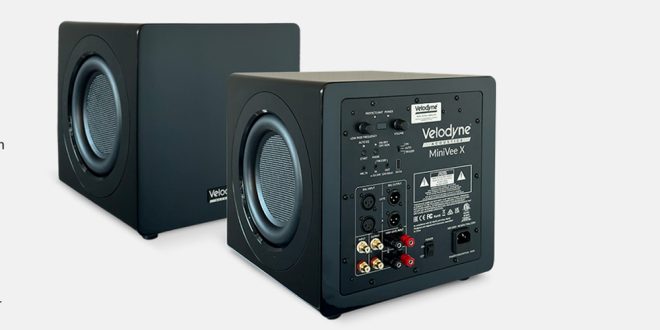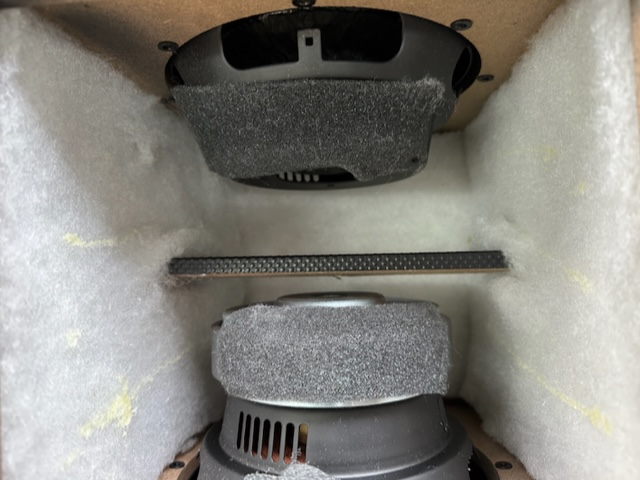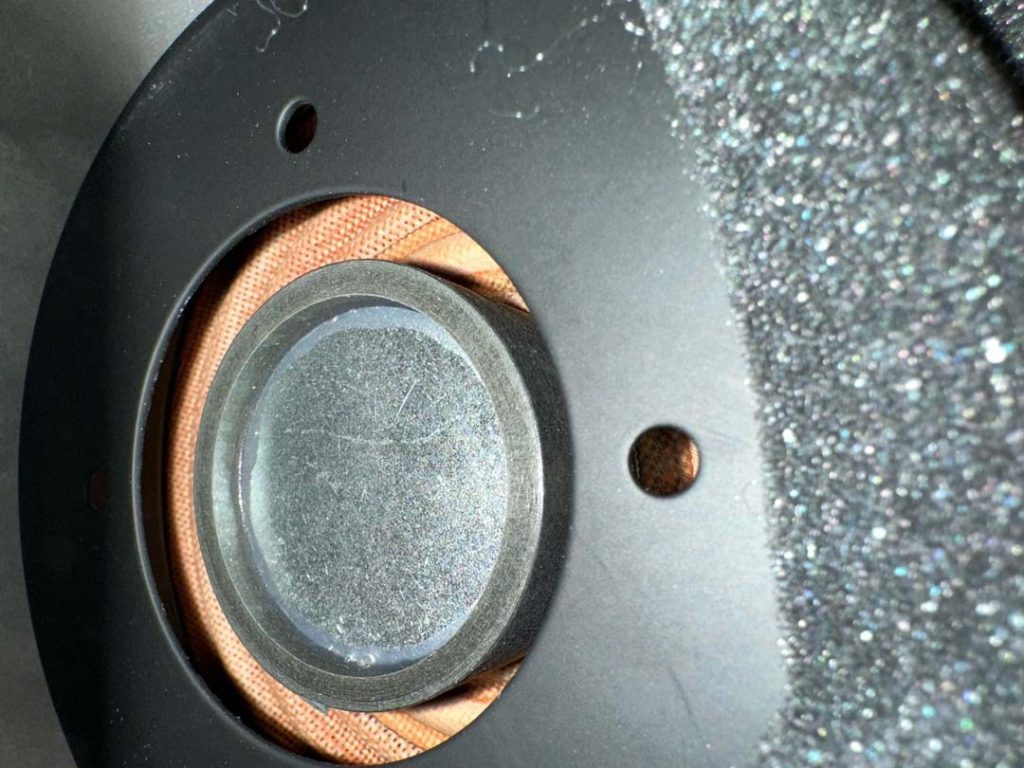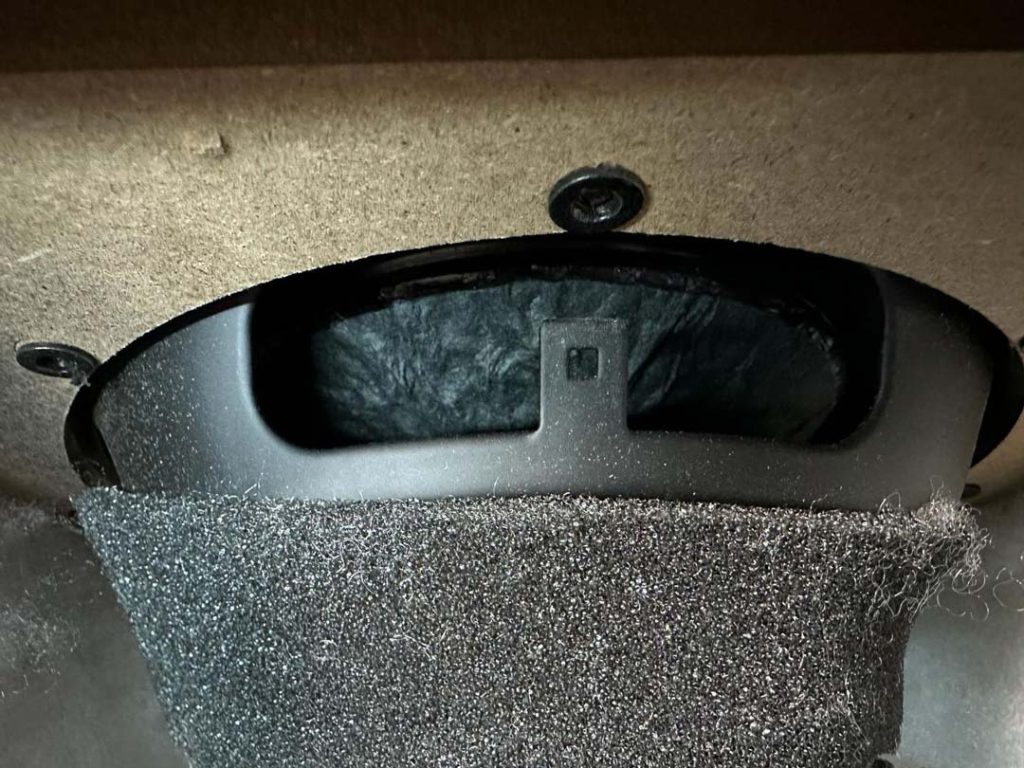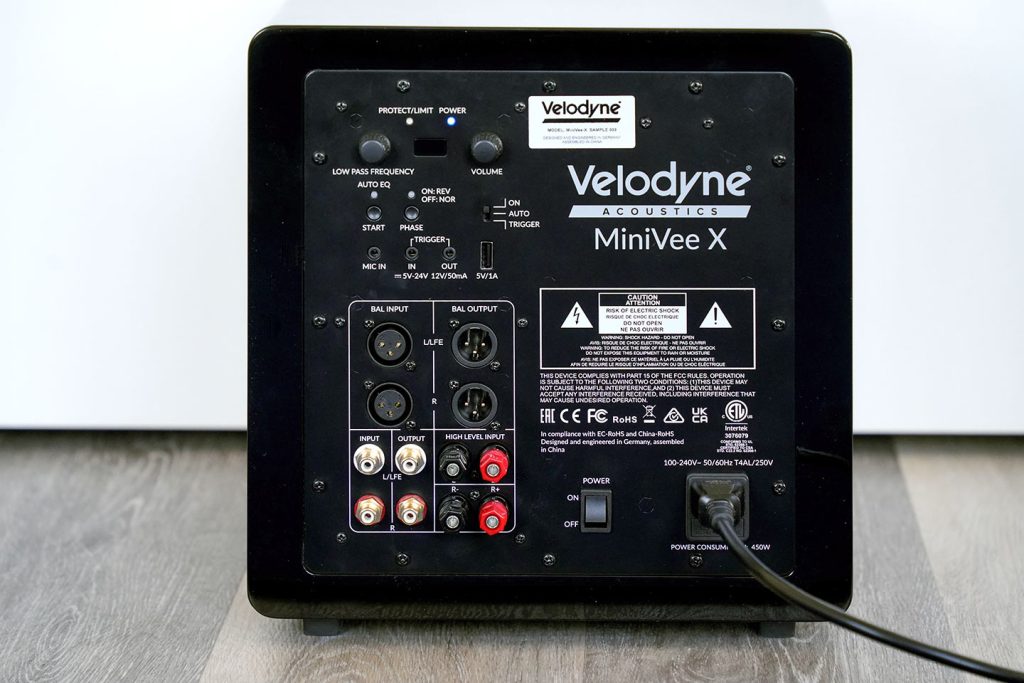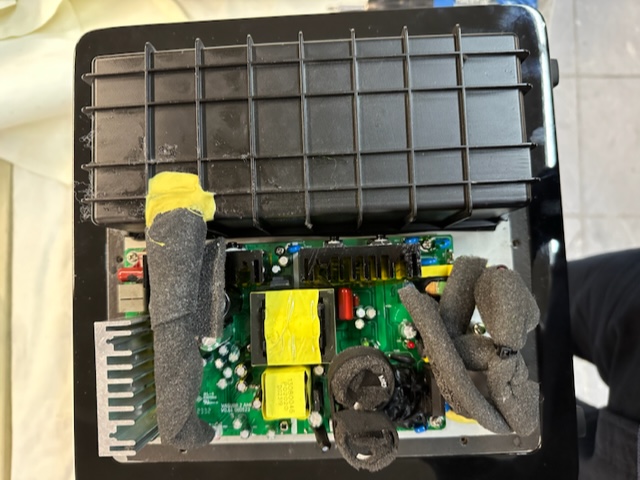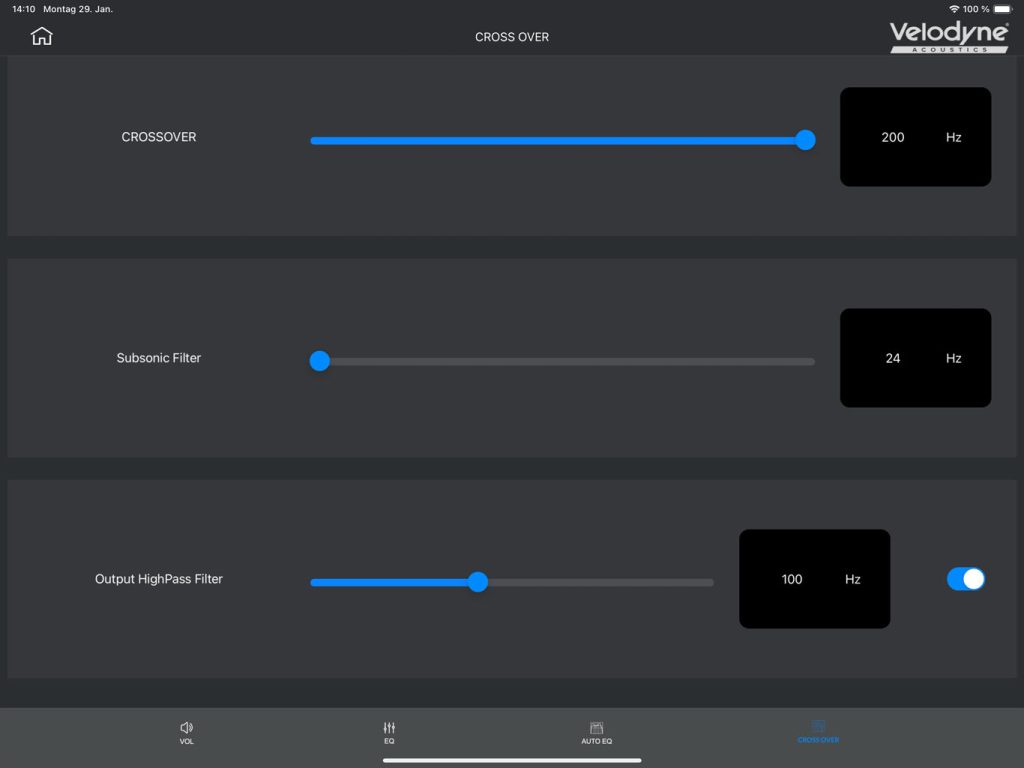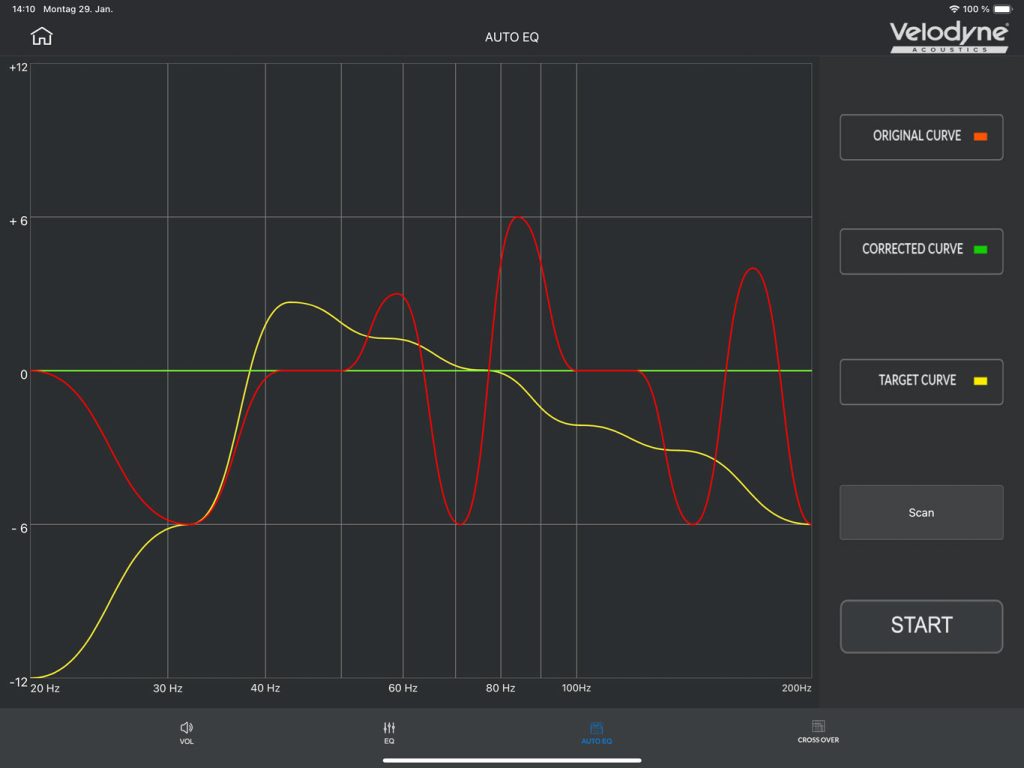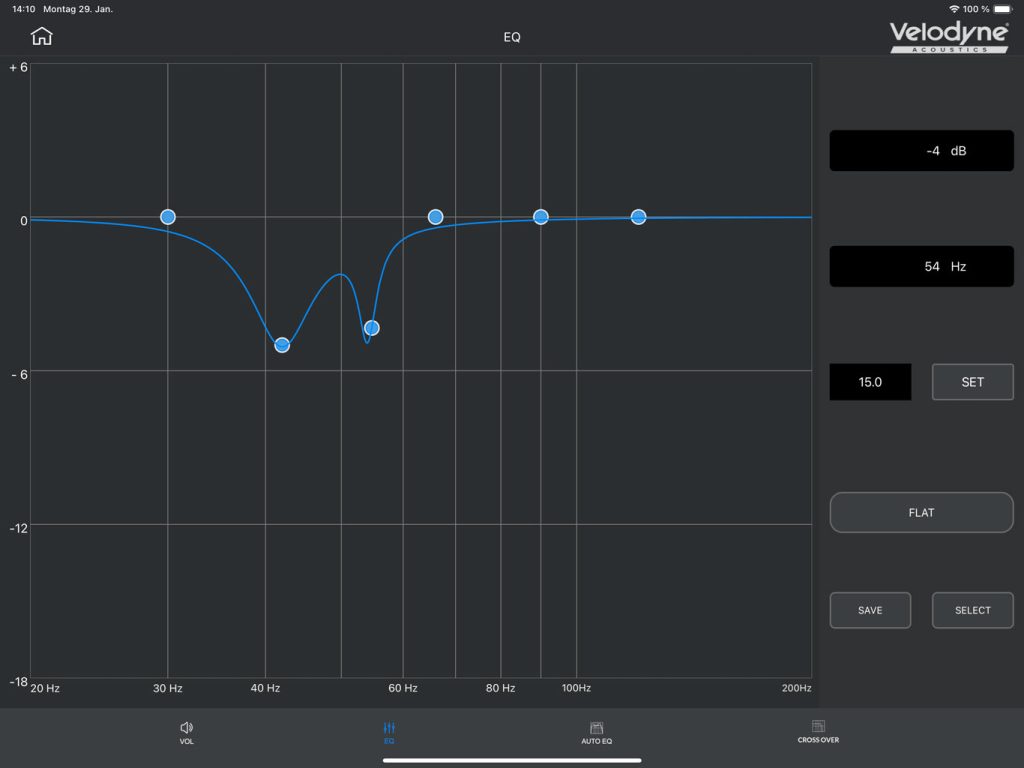Since Audio Reference from Hamburg took over the subwoofer specialist Velodyne and re-established it as Velodyne Acoustics, they have been continuously developing the brand and model series. A giant step has now been taken with the Velodyne Acoustics MiniVee X subwoofer dwarf. The compact high-gloss cube costs just 999 euros and is the first product to feature the completely new electronics that will be used in all models in the future. And it has it all.
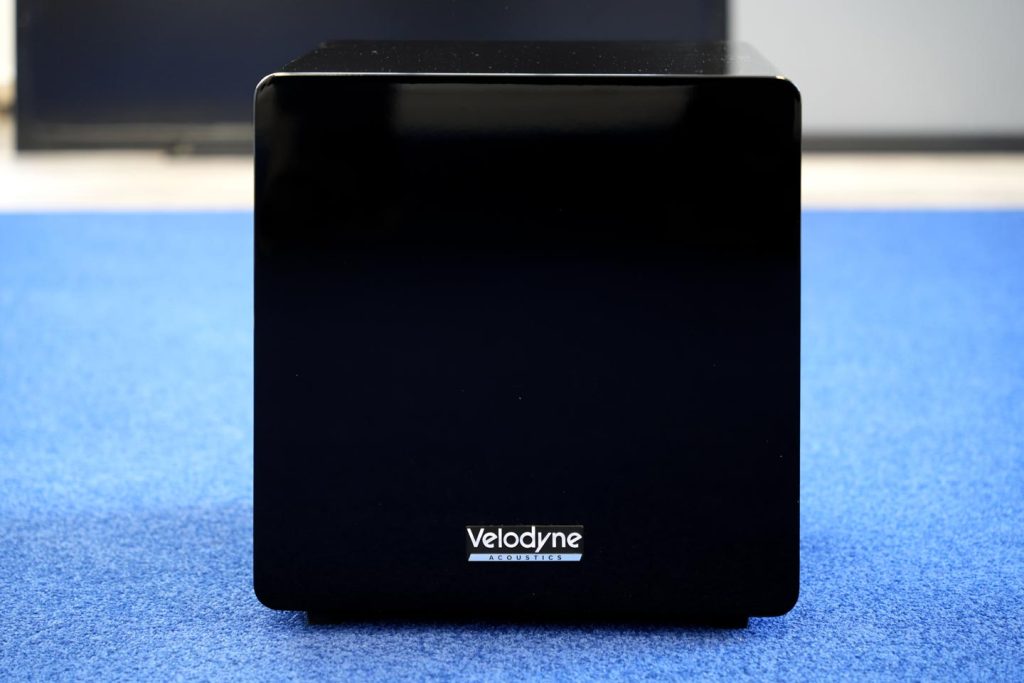
The Velodyne Acoustics MiniVee X is the logical further development of the previous MiniVee. The high-gloss black lacquered cube is slightly smaller than an LP cover, with an edge length of 29 centimeters, and has a spotless finish. There are no visible screws or other visual imperfections at the front or sides.
Velodyne Acoustics MiniVee X: elaborate workmanship
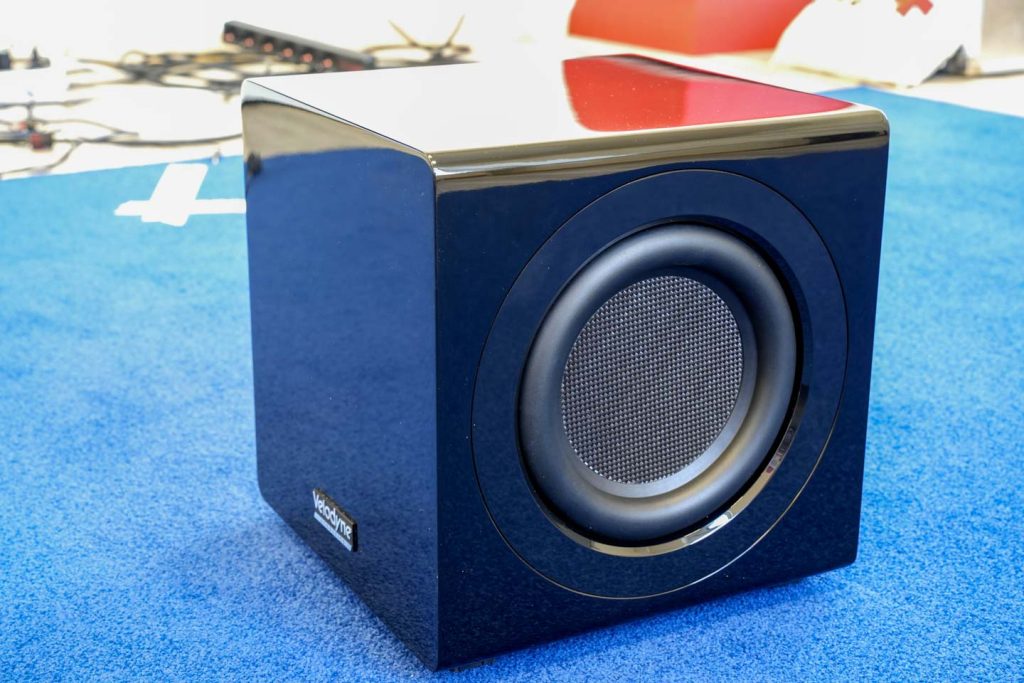
The two subwoofer drivers are positioned at the side and are framed by a discreetly offset decorative ring. The two woofers are classified as 8-inch (20 cm) and have a real diaphragm diameter of 16.5 cm – half the surround is included here. The bulging nitrile rubber surround is designed to allow a stroke of 22 mm and the fixed 4-inch spider enables a perfectly centered, wobble-free piston movement. The drive is provided by a 50 mm diameter voice coil with four layers of winding made of high-purity copper.
However, only one of the two basses is active. The second is passive and is stimulated via the internal volume. Passive cones are practically the noble version of bass reflex tubes: more expensive than a tube, but more finely tuned and, above all, “tight” for disturbing noises such as air flow and everything else that creaks and groans in the mechanics at higher levels.
A look “under the hood” shows just how much effort Velodyne Acoustics puts into this compared to other manufacturers in a similar price range. Virtually nobody adds additional bracing to such a small enclosure, especially if it is already made of thick MDF. Everything that could potentially cause airflow noise is coated with coarse-pored foam for insulation. The passive cone is not simply installed loosely: it has the same cone and, above all, the same centering as the woofer with magnetic drive. Where the voice coil would normally be, the passive diaphragm has a weight that is used to set the resonance frequency. And, as can be seen in the photos, everything is fastened with threaded bolts and machine screws instead of – as is so often the case with competitor models – with simple wood screws screwed directly into the housing. The Velodyne fastening allows for later servicing and the occasional secure tightening of the screws, and it is extremely unlikely that something will come loose during operation.
The new electronics: equipped for all eventualities
Currently, there is practically no subwoofer under 1,000 euros with better electronics than the MiniVee X. It is the first model to work with the newly developed platform. And it offers practically everything you need for music or home theater and virtually any type of control. Really any. Let’s go through this in detail:
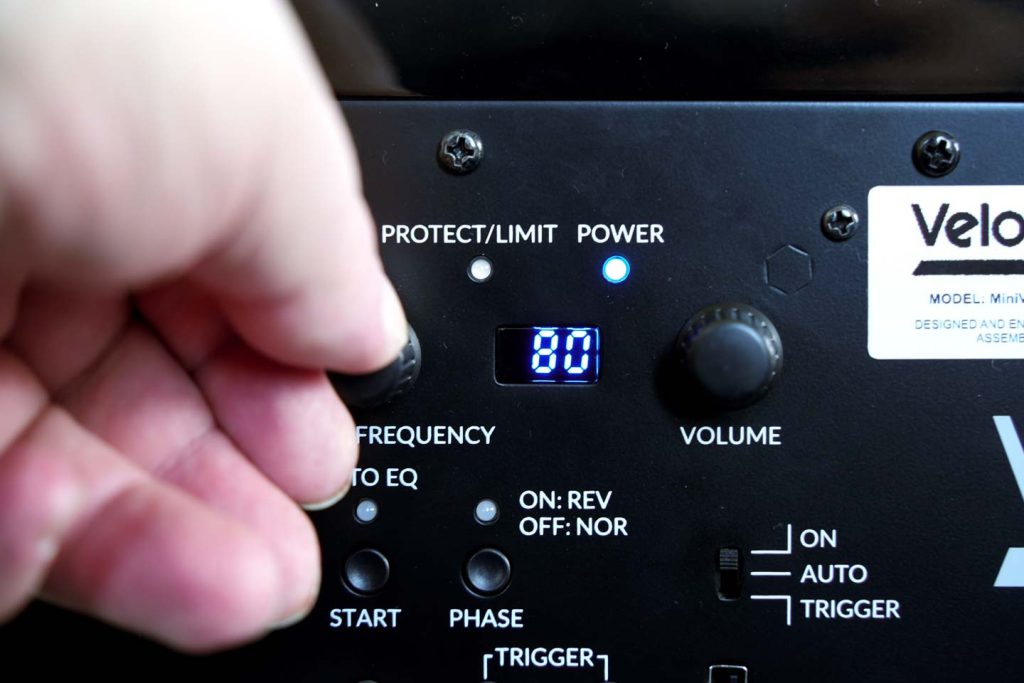
The heart beats digitally, which is an advantage for everything that has to do with filters. There are two rotary encoders at the top for the upper cut-off frequency and volume. The display in the middle shows the value of the currently moved adjuster and then goes out again.
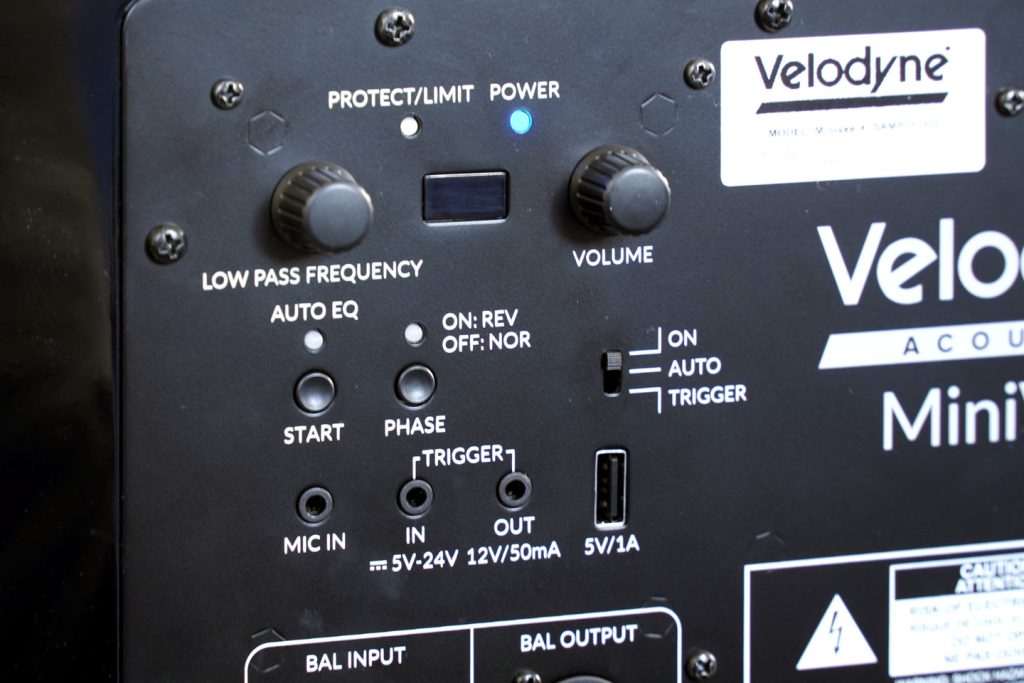
Below this, room calibration can be started (microphone with mini stand included) and the phase reversed. Then it becomes really exciting and practical. The MiniVee X is one of the few subwoofers on the market (and especially in this price range!) that can be switched on via trigger voltage from the amplifier/receiver. And it has been thought through: 5 volts is sufficient as a trigger voltage and therefore any USB socket on the amplifier or converter. But developer Thomas Wolff has gone a decisive step further and added a trigger output that can be used to switch on other devices or subwoofers. Great!
And this is where the brains are: The output signal comes with a 5-second delay! This creates a step-by-step sequence that prevents the fuse from tripping if several subwoofers or power amplifiers are switched on at the same time. Previously, you had to solve this with accessories from Antrax, for example; Velodyne Acoustics now always installs these. And those who work with wireless transmission have also been considered: the USB socket next to the trigger connections provides the 5V supply voltage that practically all of these modules require.
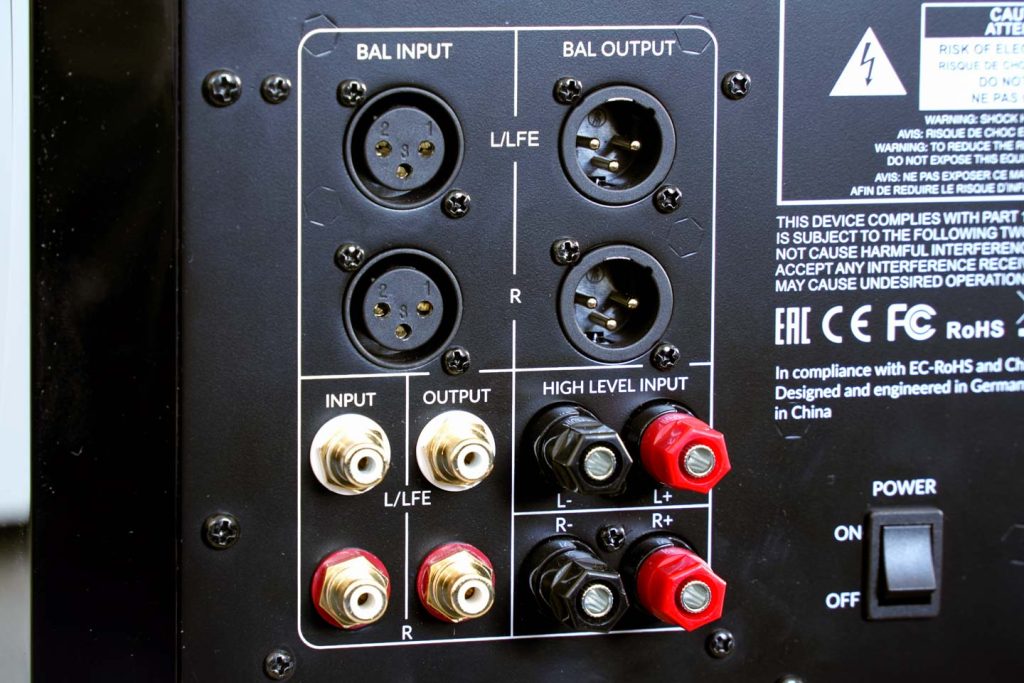
Anyone using an AV processor/receiver will have no problem controlling a subwoofer. Nowadays, most of them offer bass management, active crossover and room equalization for perfect bass. A few stereo amplifiers (such as the Parasound P 6) also offer this. Thankfully, more and more amplifiers are at least providing a separate output – even if this is often just a sum output without a filter. If you don’t have the appropriate subwoofer outputs, you will have to wire the subwoofer in parallel to the speakers – which Velodyne Acoustics has of course also provided for.
For all other cases, there are two channels (stereo) each in RCA and XLR as inputs and outputs. And because the outputs can also be filtered, the speakers and subwoofer can be perfectly matched. For example, active loudspeakers (with or without high-pass filtering) can be driven by the subwoofer. Or you can use the MiniVee X’s filtering between the preamp and power amp – or an amplifier with appropriate separation options (processor loop or tape monitor). Unfiltered, the outputs can of course also simply be used to connect additional subwoofers, so-called daisy-chaining.
The Velodyne Acoustic Auto-EQ app
All basic settings and everyday controls can be made on the subwoofer. Velodyne Acoustics has moved more in-depth details and additional functions to the app (iOS & Android). This was available in a first version, which was not quite complete, but essentially worked as it should. It offers the same basic functions as the subwoofer, but also features a more sophisticated calibration and a 6-band (parametric) equalizer with several memory locations.
Speaking of calibration: The Auto EQ function (a microphone is supplied for this purpose) can theoretically also be started using the buttons on the subwoofer. But the app is cleverer and better, because you can find a target curve here. The idea is as follows: you first make a near-field measurement and use it to generate the target curve. Then the actual room correction is to be set in motion at the listening position with “Start”, which then primarily compensates for the room problems and does not simply smooth everything out. This worked really well in the test. We are working on improving and editing the curves for future app versions. If you also want to filter manually, you can use the freely parameterizable EQ.
Something else can only be set in the app: the high-pass filters for the speakers when using the MiniVee X as an active crossover. To be more precise, a high-pass filter (subsonic) and a low-pass filter (upper cut-off frequency) for the subwoofer and the low-pass filter (lower cut-off frequency) for the speakers can be set completely independently of each other. This allows a really precise adjustment. And there’s more: not only can you daisy-chain several Velodyne subwoofers and switch them as a sequence using a delayed trigger, you can also manage them all simultaneously with the same app and name them freely, such as “MiniVee X front right”. The only thing missing at the moment is a more precise phase control for the woofer; the next app version should offer this.
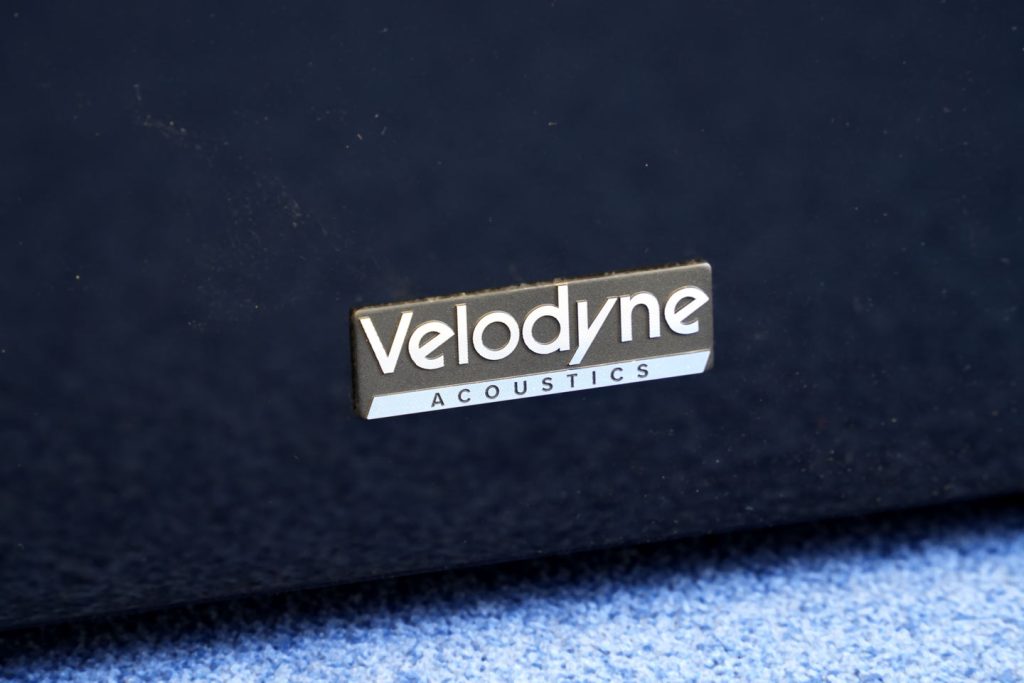
It sounds really rich and dry as dust!
And how does it sound? Considering its compact dimensions, the MiniVee X is quite powerful, although it is certainly not one of the loudest in its price range. On the other hand, it played cleaner than almost any other subwoofer under 1,000 euros – at the latest after calibration with Auto-EQ. For example, a rich bass drum simply went “boom”, not boom, not plop, just a dry “boom”.
Even at higher levels, there were no overtones, distortions or loss of precision. This is a compliment to the super-rigid cabinet construction with its bracing at the critical points and the good control of the potent amplifier over the movement of the diaphragm drive. These features make the MiniVee X sound bigger than it is. And even extreme low bass (which it reproduces at a reduced level, but cleanly) is impressively pushed into the room and remains practically undetectable due to the absence of harmonics.
Conclusion: The almost perfect (compact) subwoofer
With the Velodyne Acoustics MiniVee X, the subwoofer specialists consistently complete their line, which should also be groundbreaking for larger future models: Instead of cheap noise cubes with background noise at high levels, the Hamburg-based company focuses on low distortion thanks to ultra-rigid enclosures, passive cone instead of bass reflex and all this combined with what is probably the best and most universal electronics currently available. It offers every conceivable analog input and output as well as innovative room calibration: flexible filtering with good memory management.
The bottom line is that all the MiniVee X’s plus points add up to what is probably the best-sounding and, above all, universally applicable subwoofer under 1,000 euros. With these possibilities and its dust-dry, precise sound, I think it is currently the best addition to compact stereo speakers. And the glossy cube is pretty too…
Velodyne MiniVee X | 2024/02 |
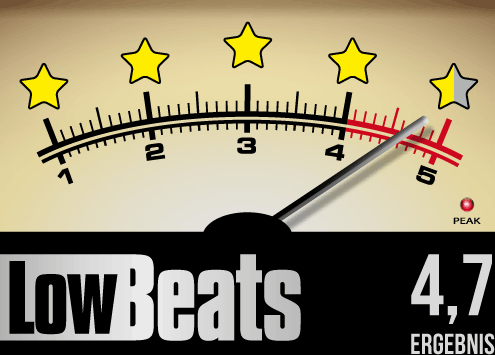 | |
Outstanding | |
Rating
Sound QualityUsabilityBuild QualitySummary |
| The rating always refers to the respective price category. |
| | Sounds precise and dry |
| | Inputs/outputs XLR, cinch, trigger |
| | Auto-EQ room calibration |
| | App for EQ, active crossover for speakers |
Distribution:
Velodyne Acoustics GmbH
Alsterkrugchaussee 435
22335 Hamburg
www.velodyneacoustics.com
Price (manufacturer’s recommendation):
Velodyne Acoustics MiniVee X: 999 Euro
| Velodyne Acoustics MiniVee X | |
|---|---|
| Chassis: | 2x 8-inch (20cm) carbon fiber flat cone, thereof 1 passive |
| Drive: | Ferrite magnet with 5 cm voice coil made of four-layer, high-purity copper |
| Suspension: | 22 mm nitrile rubber surround and 10 cm centering spider made of firm cotton |
| Amplifier: | Class-D MOSFET power amplifier |
| Performance: | 350W RMS (0.5% THD), 600W (2% THD), 800W maximum |
| Frequency response: | 26-220 Hz +/-6 dB |
| Inputs: | 2x XLR, 2x RCA, 2x speaker terminals, 5-24V trigger, measuring microphone |
| Outputs: | 2x XLR, 2x RCA, 12V trigger (5 second delay) |
| Dimensions (WxHxD): | 29x30x29cm |
| Weight: | 15kg |
| All technical data | |
More from Velodyne:
Test: Velodyne Acoustics MicroVee X – mini subwoofer further developed
Test Velodyne Acoustics VI-Q 15: extremely precise DSP subwoofer
First test Velodyne DB-15: the flagship of the new Deep Blue series
Family test: Velodyne SPL-Ultra series premium subwoofers



